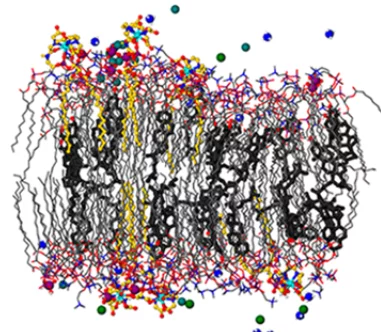Cholesterol (Chol-OH) and its conjugates are powerful molecules for engineering the physicochemical and magnetic properties of phospholipid bilayers in bicelles. Introduction of aminocholesterol (3β-amino-5-cholestene, Chol-NH2) in bicelles composed of 1,2-dimyristoyl sn-glycero-3-phosphocholine (DMPC) and the thulium-ion-chelating phospholipid 1,2-dimyristoyl-sn-glycero-3-phospho-ethanolamine-diethylene triaminepentaacetate (DMPE-DTPA/Tm3+) results in unprecedented high magnetic alignments by selectively tuning the magnetic susceptibility Δχ of the bilayer. However, little is known on the underlying mechanisms behind the magnetic response and, more generally, on the physicochemical forces governing a Chol-NH2 doped DMPC bilayer. We tackled this shortcoming with a multiscale bottom-up comparative investigation of Chol-OH and Chol-NH2 mixed with DMPC. First, simplified monolayer models on a Langmuir trough were employed to compare the two steroid molecules at various contents in DMPC. In a second step, a molecular dynamics (MD) simulation allowed for a more representative model of the bicelle bilayer while monitoring the amphiphiles and their interactions on the molecular level. In a final step, we moved away from the models and investigated the effect of temperature on the structure and magnetic alignment of Chol-NH2 doped bicelles by SANS. The DMPC/steroid monolayer studies showed that Chol-OH induces a larger condensation effect than Chol-NH2 at steroid contents of 16 and 20 mol %. However, this tendency was inversed at steroid contents of 10, 30, and 40 mol %. Although the MD simulation with 16 mol % steroid revealed that both compounds induce a liquid-ordered state in DMPC, the bilayer containing Chol-NH2 was much less ordered than the analogous system containing Chol-OH. Chol-NH2 underwent significantly more hydrogen bonding interactions with neighboring DMPC lipids than Chol-OH. It seems that, by altering the dynamics of the hydrophilic environment of the bicelle, Chol-NH2 changes the crystal field and angle of the phospholipid−lanthanide DMPE-DTPA/Tm3+ complex. These parameters largely determine the magnetic susceptibility Δχ of the complex, explaining the SANS results, which show significant differences in magnetic alignment of the steroid doped bicelles. Highly magnetically alignable DMPC/Chol-NH2/DMPE-DTPA/Tm3+ (molar ratio 16:4:5:5) bicelles were achieved up to temperatures of 35°C before a thermoreversible rearrangement into nonalignable vesicles occurred. The results confirm the potential of Chol-NH2 doped bicelles to act as building blocks for the development of the magnetically responsive soft materials of tomorrow.
- About the CentercloseAbout the Center
- Our Research
- Our User Facilities
- SINQ: Swiss Spallation Neutron Source
- SμS: Swiss Muon Source
- CHRISP: Swiss Research Infrastructure for Particle Physics
- Scientific Advisory Committees
- Publications
- Jobs & Education


